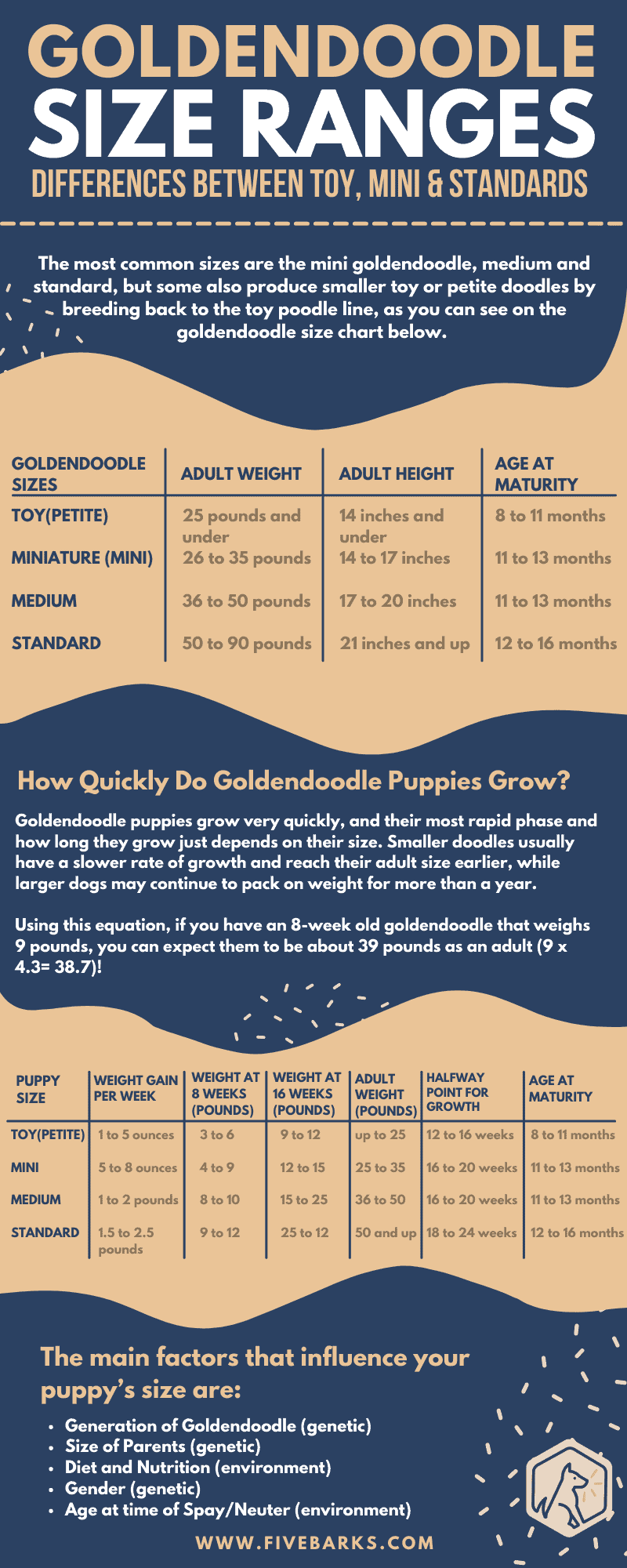If you’re looking for what sizes Goldendoodles come in, there are three types of categories: mini, medium, and standard. In this article, you and I will take a closer look at Goldendoodles and their size. I’ll also discuss the three different categories, height, and weight when fully grown, and how to predict how big your Goldendoodle will get.
Table of Contents
Size

Goldendoodles are a hybrid breed. They’re a cross between two different parent breeds, in this case, the Golden Retriever and Standard Poodle. As I mentioned, this designer breed comes in three sizes, with each size having its own distinct set of characteristics. So if both parents are mini Goldendoodles, the puppies will also be minis with that doodle size.
Mini or Micro Doodles are one of the most compact sized, toy doodles being the smallest, and their weight can vary from 10 to 15 pounds and the smallest in regard to inches in height. While they vary in size, they’re known for being active and playful and great companions for people who live just about anywhere, including small spaces like.
Medium Goldendoodles are the most popular size. They’re a good balance between the mini and the standard size and weigh between 30 and 45 pounds. They have all the best qualities of both the Golden Retriever and Standard Poodle.
Standard Goldendoodles are the biggest size. They can weigh anywhere from 50 to 90 pounds, making them one of the larger hybrid breeds. These doodles make great family pets because they are so loyal and loving, but they may need plenty of space to run and play, depending on their energy level.
Temperaments
Goldendoodles should have the following characteristic temperaments:
- Friendly
- Outgoing
- Active
- Playful
- Loyal
- Intelligent
- Affectionate
Size Matters
A Goldendoodle’s height and weight as an adult can vary depending on the size of the parents. Sometimes the puppies can have some weight differences between them and their parents because of genetics. Here below, I mention the different size options and size variations.
- Mini Goldendoodle: Smallest size category, can weigh between 10 and 15 pounds, very active and playful, a splendid companion for people living in small spaces.
- Medium Goldendoodle: Most popular and perfect size, a good balance between mini Goldendoodles and standard Goldendoodles; weighs 30 to 45 pounds; loyal, intelligent, affectionate dogs that get along well with adults and children.
- Standard Goldendoodle: Can weigh anywhere from 50 to 90 pounds; loyal and loving, making them perfect family pets but may require plenty of space depending on their energy level and activity level; are adorable as their smaller counterparts!
Typical Weights for Each Size
It usually takes Goldendoodles from 12 months to 2 years old to reach their full adult size. The parent’s size can be important in the size of a fully grown Goldendoodle. Usually, when you’re looking for a Goldendoodle of a certain size, you need to be mindful of their growing bones as they grow. You’ll also want to keep track of their weight.
Average Puppy’s Weight During Development
Their size can vary depending on the parents of minis or micro doodles, so this is just a Goldendoodle size chart for the usual growth pattern for most dogs from my experience over the years.
Minis and medium-sized Goldendoodles weight in pounds in a couple of months:
- 10-15 pounds at 6 months old
- 15-20 pounds at 12 months old
- 20-25 pounds at 18 months old
- 25-30 pounds at 2 years old
Minis and medium-sized Goldendoodles weight in pounds in a couple of months:
- 30-45 pounds at 6 months old
- 45-60 pounds at 12 months old
- 60-75 pounds at 18 months old
- 75-90 pounds at 2 years old
If you have questions about your Goldendoodle’s growth or if you’re concerned about your dog being underweight or overweight, talk to your veterinarian. They’ll be able to help you decide if your dog is on track to reach their full adult size or if there’s cause for concern.
Predicting Weight and Size
There are three ways you can predict how big your pup will get. These methods look at the size of the parents, the size of the littermates, and by how big the Goldendoodle is at 12 weeks old.
The size of the parents is the most important factor in predicting your pup’s size. If both parents are mini Goldendoodles, then it’s likely that their puppies will also be mini Goldendoodles.
The size of the littermates can also give you an idea of how big your Goldendoodle will be when fully grown. If all the other puppies in the litter are mini Goldendoodles, then your puppy will also be a mini Goldendoodle. However, if there is a mix of sizes in the litter, then it’s harder to predict how big your puppy will be.
The third way to predict how big your Goldendoodle will be is by looking at how big they were at 12 weeks old. This method is not as accurate as looking at the size of the parent dogs or littermates, but it can give you a pretty good idea of what their exact size will be.
You’ll want to multiply your puppy’s weight by 4.2 at 12 weeks, giving you a good baseline for where they should be as an adult. There are also calculators out there for this purpose.
To recap:
- Look at the size range of the Goldendoodle’s parents for an idea of your pup’s adult weight.
- Observe the Goldendoodle’s littermate assortment of sizes to see the average full-grown size.
- Multiply Goldendoodle’s weight by 4.2 when it is 12 weeks old.
Growth and Development

Goldendoodles grow relatively quickly, with most reaching their adult size within their first year of life. Here’s a rough timeline of their growth and development:
- Birth to 4 weeks: During this time, Goldendoodle puppies entirely depend on their mother’s milk for nourishment. They will spend most of their time sleeping and growing.
- 4 to 8 weeks: Puppies will become more active and playful during this time. They will explore their surroundings and interact with their littermates.
- 8 to 12 weeks: This is a critical time for socialization and training. Puppies will learn basic commands and develop their personalities.
- 3 to 6 months: Goldendoodles will continue to grow rapidly during this time, and their energy levels will increase. They will also lose their baby teeth and develop their adult teeth.
- 6 to 12 months: Most Goldendoodles will reach their adult size during this time. They will continue to develop their personalities and can be fully trained by the end of this stage with mental stimulation and positive reinforcement to prevent behavioral issues.
It’s important to note that all dogs are individuals, and their growth and development can vary depending on their combination of genes, environment, and overall health. Regular checkups with a veterinarian can ensure that your pup is developing as expected.
Doodles Can Stop Growing at Any Point
Goldendoodles can stop growing at any point in their development for a variety of reasons. One reason is that they don’t have enough food or nutrients. If a doodle isn’t getting enough to eat, their growth can be stunted.
A lack of food or nutrients can cause a doodle to stop growing or to grow more slowly than usual. If you’re concerned that your Goldendoodle isn’t getting enough to eat, talk to your vet about changing their diet or supplementing their food with vitamins and minerals.
You’ll need to do the following for basic care with your puppy during their developmental years:
- Keep up with regular vet checkups to ensure they are healthy and growing as expected.
- Make sure your Goldendoodle has enough space to move around with no hindrances in order for them to develop fully.
- Socialize your pup regularly by introducing them to new people, animals, or environments.
- Ensure that all vaccinations are kept up-to-date for optimal health and growth.
- Follow recommended care guidelines from reputable sources such as vets or reputable breeders.
If a Goldendoodle is ill or has a medical condition, their growth can be affected. Illness and medical conditions can cause a Goldendoodle to stop growing or to grow more slowly than usual. If you’re concerned that your pup might be ill or have a medical condition, I will always suggest you talk to your vet.
- Genetic disorders: Certain genetic diseases, such as dwarfism and hip dysplasia, can affect Goldendoodles’ growth and development.
- Parasite infestations: Internal parasites such as roundworms and hookworms can cause Goldendoodles to stop growing or not reach their full potential. Symptoms include a distended belly, vomiting, and diarrhea.
- Neutering: Early neutering can cause Goldendoodles to stop growing sooner than they would have otherwise. Talk to your vet about the best time to neuter your Goldendoodle based on their size.
A Goldendoodle may reach its full adult size early in life. If a Goldendoodle reaches its full adult size before its 1-year-old, it’s considered to be early onset adulthood. Genetics can cause the early onset of adulthood or the environment in which the Goldendoodle lives.
If you’re concerned that your Goldendoodle might reach its full adult size early in life, I would suggest talking to your vet about it.
- Monitor your doodle’s eating habits to ensure they are getting enough food and nutrients for proper growth.
- Provide a nutritious diet with adequate levels of protein and fat.
- Feed your Goldendoodle several meals throughout the day, so they don’t miss out on important nutrients.
- Make sure your Goldendoodle gets plenty of exercises to ensure their growth is properly supported. I provide some caution here, though, as too much exercise can put too much strain on their growing joints.
- Give access to clean drinking water throughout the day & monitor signs of dehydration or other health issues promptly, and address them accordingly if needed.
Conclusion
Goldendoodles, as designer dogs, come in three size categories: mini, medium, and standard. They grow relatively quickly, with most reaching their adult size within the first year of life.
To ensure your Goldendoodle is growing properly, it’s important to monitor its eating habits, provide a nutritious diet with adequate levels of protein and fat, feed them several meals throughout the day for proper nutrition, give access to clean drinking water throughout the day, & keep up with regular vet checkups.
By following these steps, you can help ensure that your Goldendoodle reaches its full potential growth while staying healthy!
What do you think of Goldendoodles? Do you have one? Have you trained yours for anything specific such as being a therapy dog? Tell us about your experiences!


what are the best breeds mother and father to procuce a goldendoodle
Goldendoodles are made by breeding a golden retriever with a poodle, the puppies are called F1. Many goldendoodle are bred by a goldendoodle breeding with a poodle, those puppies are called F1B. Sometimes you can find a backcross of a golden instead of poodle. Those puppies are also called F1B but specified backcross with golden retriever.
Very helpful and easy to understand information. Thank you!
I was looking the information about Mini Golden doodle when I Came Across on your post, Awesome your post helped me a lot. Thanks keep it up..